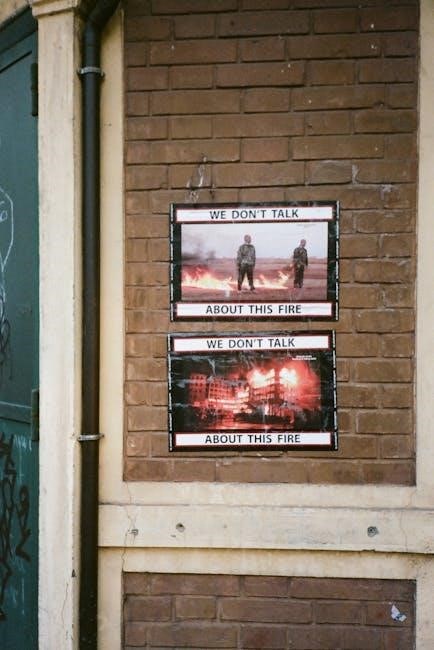Manual call point signs are essential components of fire safety systems, indicating locations of fire alarm activation points. These signs are typically red, complying with ISO 3864 and EN 54-11 standards, ensuring quick identification and activation in emergencies.
1.1 Definition and Purpose
A fire alarm manual call point sign is a visual marker indicating the location of a manual call point, a device used to trigger fire alarms. Its purpose is to guide individuals to these points quickly, ensuring timely alarm activation in emergencies. These signs are integral to fire safety systems, promoting swift response and enhancing overall safety and compliance with regulations.
1.2 Importance in Fire Safety Systems
Manual call point signs play a critical role in fire safety by enabling quick identification of alarm activation points. Their visibility ensures rapid response, minimizing potential risks during emergencies. Compliance with ISO 3864 and EN 54-11 standards guarantees their effectiveness, making them indispensable for safe evacuation and fire incident management in buildings.

Design and Features
Fire alarm manual call point signs are designed with standard colors, photoluminescent finishes, and various sizes to ensure visibility and compliance with safety regulations like ISO 3864-1 and ISO 3864-4.
2.1 Standard Colors and Compliance (ISO 3864, ISO 7010)
Fire alarm manual call point signs must adhere to ISO 3864 and ISO 7010 standards, utilizing specific safety colors. The signs typically feature a red background with white symbols, ensuring high visibility and immediate recognition. Compliance with these standards is crucial for maintaining consistency and effectiveness in emergency communication and safety protocols worldwide.
2.2 Photoluminescent (Glow-in-the-Dark) Finish
Photoluminescent finishes on fire alarm manual call point signs enhance visibility in low-light conditions. These signs absorb light and emit a glow, ensuring call points remain identifiable during power outages or at night. This feature is critical for maintaining safety and enabling quick activation of fire alarms, even in complete darkness, thus aiding in timely evacuations and emergency responses.
2.3 Size and Dimension Options
Fire alarm manual call point signs are available in various sizes, including 100mm x 150mm, 148mm x 148mm, and larger formats. These dimensions ensure visibility and compliance with safety standards. Additionally, signs can be tailored to fit specific spaces while maintaining readability and accessibility, ensuring they are easily noticeable in emergency situations.

Installation Requirements
Manual call point signs must be installed along escape routes, at a height of 1.4m to 1.6m, ensuring visibility and compliance with BS 5839-1:2017 standards.
3.1 Placement Along Escape Routes
Manual call point signs must be placed along escape routes, ensuring visibility and accessibility. They should be positioned at intervals that do not exceed 30 meters, and at every change of direction. This placement facilitates quick activation during emergencies, aligning with regulatory requirements to minimize delays and ensure safe evacuation. Compliance with BS 5839-1:2017 is essential for optimal safety.
3.2 Height and Visibility Standards
Manual call point signs must be installed at a height of 1.4 meters ± 0.2 meters to ensure visibility and accessibility. They should be positioned in areas with clear lines of sight, avoiding obstructions. Signs must comply with ISO 3864 and ISO 7010 standards, featuring photoluminescent finishes for visibility in low-light conditions, ensuring they remain identifiable during emergencies. Proper placement enhances safety and compliance with fire safety regulations.
3.3 Compliance with BS 5839-1:2017
Manual call point signs must comply with BS 5839-1:2017, the British Standard for fire alarm systems. This standard requires signs to be clearly visible, positioned near call points, and consistent in design. Compliance ensures proper functionality, safety, and adherence to regulatory requirements, enhancing emergency response efficiency and maintaining building safety standards effectively.

Types of Manual Call Point Signs
Manual call point signs are available in various forms, including rigid signs, adhesive vinyl stickers, and other materials, each designed for specific applications and environments.
4.1 Rigid Signs
Rigid manual call point signs are durable, long-lasting, and suitable for heavy-use environments. Made from materials like plastic or metal, they are resistant to wear and tear. These signs are often mounted on walls or other surfaces, ensuring clear visibility. Rigid signs are ideal for high-traffic areas and outdoor locations, providing reliable fire safety information. They meet ISO and EN standards, ensuring compliance and effectiveness in emergency situations.
4.2 Adhesive Vinyl (PVC) Stickers
Adhesive vinyl (PVC) stickers are a cost-effective and versatile option for marking fire alarm call points. They are easy to install and can be applied to various surfaces, including walls and equipment. These stickers are durable, water-resistant, and come in multiple sizes. PVC stickers are ideal for temporary or permanent use and can be easily removed without damaging the surface.
4.3 Other Materials and Finishes
Beyond rigid signs and PVC stickers, fire alarm call point signs are available in various other materials and finishes. Photoluminescent finishes enhance visibility in low-light conditions, while glow-in-the-dark options ensure clarity during power outages. Additionally, some signs feature protective laminates or anti-vandalism coatings, extending durability and performance in harsh environments. These options ensure versatility for different building requirements and safety standards.
Regulatory Compliance
Fire alarm manual call point signs must comply with EN 54-11:2001 and BS 5839-1:2017 standards, ensuring proper functionality and visibility. Compliance guarantees adherence to safety regulations, including ISO 3864 and ISO 7010 standards for color and design consistency. Declaration of Performance (DoP) requirements further validate product reliability and legal conformity in EU markets.
5.1 EN 54-11:2001 Standards
EN 54-11:2001 outlines requirements for manual call points in fire alarm systems, ensuring reliability and functionality. It mandates strict design and operational criteria, including visibility, accessibility, and durability. Compliance with this standard ensures devices meet European safety regulations, providing clear visual and tactile indicators for activation. It also aligns with ISO 3864 for color consistency, enhancing emergency response effectiveness and legal conformity.
5.2 BS EN 54-11:2001 Definitions
BS EN 54-11:2001 defines manual call points as devices enabling manual initiation of fire alarms. It categorizes them into types, such as Type A, which operate automatically upon activation, emphasizing clear visual indicators and tactile feedback. These definitions ensure uniformity in design and function, facilitating compliance with European fire safety standards and promoting effective emergency response systems across the UK.
5.3 Declaration of Performance (DoP) Requirements
A Declaration of Performance (DoP) is mandatory for fire alarm manual call point signs, ensuring compliance with EU directives. It includes the product’s intended use, performance characteristics, and conformity to standards like EN 54-11:2001. Manufacturers must provide DoP numbers (e.g., 0843-CPR-1073) and third-party testing certifications, guaranteeing the product meets essential fire safety and durability requirements for reliable operation in emergencies.
Maintenance and Testing
- Regular inspections ensure fire alarm manual call point signs remain visible and functional.
- Cleaning and dust removal are essential for maintaining readability.
- Testing includes verifying photoluminescent properties and checking for damage or wear.
- Replace signs if they show significant deterioration or fail visibility standards.
6.1 Regular Inspection Requirements
Regular inspections of fire alarm manual call point signs ensure they remain visible and functional. Checks include cleanliness, absence of damage, and compliance with ISO 3864 and EN 54-11. The photoluminescent finish and correct height placement between 1.4m to 1.6m are verified to ensure visibility in all conditions, crucial for effective emergency response.
6.2 Cleaning and Upkeep Guidelines
Regular cleaning of fire alarm manual call point signs is crucial for maintaining visibility. Use a damp cloth with mild detergent to remove dirt or grime. Avoid abrasive materials that could damage the surface or photoluminescent finish. Signs should be cleaned on a regular basis to ensure they remain legible and compliant with ISO 3864 and EN 54-11 standards for safety and effectiveness in fire situations.
6.3 Replacement Criteria
Manual call point signs should be replaced if they show signs of wear, damage, or fading. Replace signs when they no longer meet ISO 3864 or EN 54-11 requirements for legibility and color standards. Photoluminescent signs must glow as specified after cleaning or if their effectiveness diminishes over time, ensuring reliability in emergency situations and compliance with fire safety regulations for clear visibility and safety.

Integration with Fire Safety Equipment
Manual call point signs integrate seamlessly with fire alarm systems, enhancing their functionality. They ensure quick activation and clear visibility, working in tandem with other safety devices for optimal emergency response;
7.1 Compatibility with Fire Alarm Systems
Manual call point signs are designed to integrate seamlessly with existing fire alarm systems, ensuring instantaneous activation and clear communication. Their compatibility enhances overall system efficiency, providing reliable emergency alerts and ensuring safety protocols are met effectively.
7.2 Role in Emergency Evacuation Plans
Manual call point signs play a crucial role in emergency evacuation plans by clearly marking fire alarm locations. This ensures quick activation during emergencies, facilitating timely evacuations and reducing risks. Their visibility and strategic placement are vital for effective emergency response, aligning with safety standards to prioritize occupant safety and efficient evacuation processes.
Visibility and Readability
Fire alarm manual call point signs are designed with standardized colors and photoluminescent finishes to ensure high visibility, even in low-light conditions, guaranteeing clear identification and quick response during emergencies.
8.1 Signage in Low-Light Conditions
Fire alarm manual call point signs often feature photoluminescent finishes, ensuring visibility in low-light environments. These signs absorb light and emit a glow, maintaining legibility even during power outages or at night, critical for quick identification and activation in emergencies. Compliance with ISO 3864 and ISO 7010 ensures consistent, recognizable designs for optimal safety and rapid response.
8.2 Distance and Angle Visibility Standards
Fire alarm manual call point signs must be visible from a minimum distance of 30 meters and at an optimal viewing angle to ensure clarity. Signs are typically positioned at 1.4 meters high, with specific tolerances, to meet ISO 3864 and ISO 7010 standards, ensuring readability and compliance for safety and quick identification in emergencies.

Product Comparisons
Product comparisons reveal options like Jalite and Brady Europe signs, offering rigid, PVC, or photoluminescent finishes. Prices vary from £9.27 to £4.64, with sizes such as 148mm x 148mm, catering to different needs and budgets.
9.1 Popular Brands and Models
Popular brands include Jalite, Brady Europe, and Federal Signal, offering high-quality manual call point signs. Jalite’s fire alarm sign is a bestseller, known for its photoluminescent finish. Brady Europe’s ISO 7010 compliant sign features a clear vector design. Additionally, Amazon offers a 5-piece PVC sticker set with self-adhesive backing, ideal for quick installation. These brands ensure durability, visibility, and compliance with safety standards.
9.2 Features and Pricing
Manual call point signs vary in price, starting from £5 for basic PVC stickers to £15 for rigid, photoluminescent versions. Features include ISO 3864 compliance, glow-in-the-dark finishes, and durable materials like rigid plastic. High-end models may offer additional features such as anti-tamper mechanisms or enhanced visibility. Pricing depends on size, material, and brand, ensuring options for all budgets and requirements.
Historical Development
Manual call point signs have evolved from basic pull stations to integrated, standardized systems, reflecting advancements in fire safety technology and regulatory requirements over the years.
10.1 Evolution of Manual Call Point Signs
The evolution of manual call point signs reflects advancements in fire safety standards and technology. Early systems used simple pull stations, while modern signs incorporate photoluminescent materials and standardized colors, enhancing visibility and compliance with regulations like ISO 3864 and EN 54-11. This progression ensures clearer communication and faster response times during emergencies.
10.2 Technological Advancements
Technological advancements have enhanced the functionality of manual call point signs, incorporating photoluminescent finishes for low-light visibility and standardized symbols for universal recognition. Integration with digital fire alarm systems and compliance with ISO 3864 ensure consistent messaging and reliability. These innovations improve emergency response efficiency and alignment with global safety standards.

Role in Fire Safety
Manual call point signs play a crucial role in fire safety by enabling quick activation of alarms, ensuring timely evacuations and compliance with safety regulations, thereby safeguarding lives.
11.1 Reducing Response Time
Manual call point signs are a critical tool for reducing response time during emergencies. Their clear visibility and strategic placement along escape routes enable quick activation, minimizing delays and ensuring timely alerts. Compliance with ISO 3864 and EN 54-11 standards guarantees their effectiveness in emergency situations, making them indispensable for rapid fire response and evacuation processes.
11;2 Ensuring Compliance and Safety
Manual call point signs ensure compliance with fire safety regulations by providing clear, standardized indicators of alarm locations. Their design, adhering to ISO 3864 and EN 54-11 standards, guarantees visibility and quick identification. Photoluminescent finishes enhance low-light visibility, ensuring safety during evacuations. Compliance with these standards is crucial for maintaining reliable fire safety systems and protecting occupants effectively in emergency situations.
Fire alarm manual call point signs are crucial for ensuring quick identification and activation of fire alarms, complying with ISO 3864 and EN 54-11 standards. Their visibility, even in low-light conditions, enhances safety and facilitates rapid emergency responses, making them indispensable in fire safety systems.
12.1 Summary of Key Points
Manual call point signs are critical for fire safety, ensuring quick identification of alarm activation points. Compliant with ISO 7010 and EN 54-11, they feature photoluminescent finishes for visibility in low-light conditions. Proper placement along escape routes enhances accessibility during evacuations. Their effectiveness in triggering rapid responses makes them a vital component of modern fire safety systems.
12.2 Final Thoughts on Implementation
Implementing manual call point signs is crucial for enhancing fire safety. Ensure compliance with ISO 7010 and EN 54-11 standards for visibility and design. Regular maintenance and strategic placement along escape routes are essential; These signs play a vital role in emergency response, making their proper installation and upkeep indispensable for ensuring safety and efficiency in fire situations.



